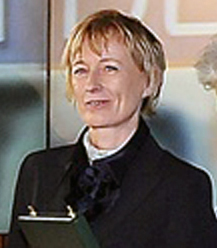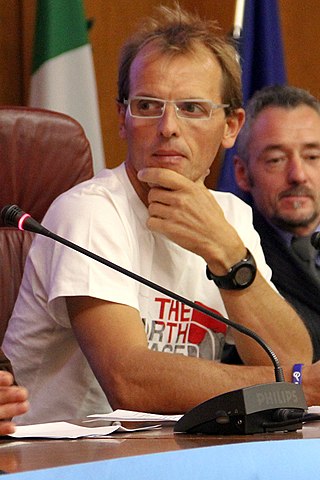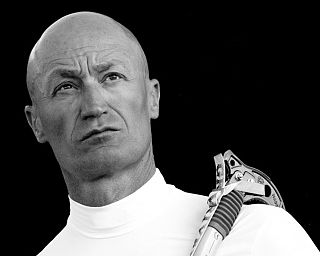
Annapurna is a mountain situated in the Annapurna mountain range of Gandaki Province, north-central Nepal. It is the 10th highest mountain in the world at 8,091 metres (26,545 ft) above sea level and is well known for the difficulty and danger involved in its ascent.
The Seven Summits are the highest mountains on each of the seven traditional continents. Reaching the peak of these summits is considered a significant achievement amongst many mountaineers, alongside many other such goals and challenges in the mountaineering community. On 30 April 1985, Richard Bass became the first climber to reach the summit of all seven.

Lhotse is the fourth highest mountain in the world at 8,516 metres (27,940 ft), after Mount Everest, K2, and Kangchenjunga. The main summit is on the border between Tibet Autonomous Region of China and the Khumbu region of Nepal.

Reinhold Andreas Messner is an Italian climber, explorer, and author from South Tyrol. He made the first solo ascent of Mount Everest and, along with Peter Habeler, the first ascent of Everest without supplemental oxygen. He was the first person to climb all 14 eight-thousanders, doing so without supplementary oxygen. Messner was the first to cross Antarctica and Greenland with neither snowmobiles nor dog sleds and also crossed the Gobi Desert alone. He is widely considered to be the greatest mountaineer of all time.

Cho Oyu is the sixth-highest mountain in the world at 8,188 metres (26,864 ft) above sea level. Cho Oyu means "Turquoise Goddess" in Tibetan. The mountain is the westernmost major peak of the Khumbu sub-section of the Mahalangur Himalaya 20 km west of Mount Everest. The mountain stands on the China Tibet–Nepal Koshi Pradesh border.

The eight-thousanders are the 14 mountains recognised by the International Mountaineering and Climbing Federation (UIAA) as being more than 8,000 metres (26,247 ft) in height above sea level, and sufficiently independent of neighbouring peaks. There is no precise definition of the criteria used to assess independence, and, since 2012, the UIAA has been involved in a process to consider whether the list should be expanded to 20 mountains. All eight-thousanders are located in the Himalayan and Karakoram mountain ranges in Asia, and their summits are in the death zone.

Gasherbrum II ; surveyed as K4, is the 13th highest mountain in the world at 8,035 metres (26,362 ft) above sea level. It is the third-highest peak of the Gasherbrum massif, and is located in the Karakoram, on the border between Gilgit–Baltistan, Pakistan and Xinjiang, China. The mountain was first climbed on July 7, 1956, by an Austrian expedition which included Fritz Moravec, Josef Larch, and Hans Willenpart.

Alan Hinkes OBE is an English Himalayan high-altitude mountaineer from Northallerton in North Yorkshire. He is the first British mountaineer to claim all 14 Himalayan eight-thousanders, which he did on 30 May 2005.

The Seven Second Summits are the second-highest mountains of each of the seven continents. All of these mountains are separate peaks rather than a sub-peak of the continents' high point. The Seven Second Summits are considered a harder challenge than the traditional Seven Summits.

Nives Meroi is an Italian mountaineer and a climbing writer. On 11 May 2017 she completed the ascent of all 14 eight-thousanders using the alpine style of climbing and without supplementary oxygen.

Simone Moro is an Italian mountaineer known for having made first winter ascents of four of the fourteen eight-thousanders: Shishapangma in 2005, Makalu in 2009, Gasherbrum II in 2011, and Nanga Parbat in 2016. No other climber has made more first winter ascents of an eight-thousander in history. He has summited Everest four times, in 2000, 2002, 2006, and 2010.
Andrew James Lock OAM is an Australian mountaineer. He became the first, and still remains the only, Australian to climb all 14 "eight-thousanders" on 2 October 2009, and is the 18th person to ever complete this feat. He climbed 13 of the 14 without bottled oxygen, only using it on Mount Everest, which he has summited three times. He retired from eight-thousander climbing in 2012.
Victor Saunders is a British climber and author. He trained as an architect at the Architectural Association School of Architecture in London. His first book, Elusive Summits, won the Boardman Tasker Prize for Mountain Literature in 1991. He became as a UIAGM/IFMGA ski and mountain guide in 1996 and joined the SNGM in 2003. Saunders first reached the summit of Mount Everest in May 2004, and went on to climb it several more times. In 2020 he became president of the Alpine Club.

Christian Stangl is an Austrian alpine style mountaineer and mountain guide. He has become known as Skyrunner by numerous exceptionally fast ascents of high mountains. His major success was in 2013, when he became the first person to ascend the three highest mountains on all seven continents, the so-called Triple Seven Summits.
Jan Fredrik Ericsson was a Swedish mountaineer and extreme skier. He grew up in Umeå in the northern part of Sweden, but spent most of his time in Chamonix, in the French Alps.

Ueli Steck was a Swiss rock climber and alpinist. He was the first to climb Annapurna solo via its South Face, and set speed records on the North Face trilogy in the Alps. He won two Piolet d'Or awards, in 2009 and 2014. Having previously summitted Mount Everest, Steck died on 30 April 2017, after a fall during an acclimatizing climb for an attempt on the Hornbein route on the West Ridge of Everest without supplemental oxygen.

Silvio Mondinelli, is an Italian climber. In the year 2007, he became the 13th person to climb the 14 eight-thousanders. He is the 6th person to achieve that feat without using supplemental oxygen. He was 49 years old when he summited the last of the 14 summits, a task he started in 1993 and finished in 2007.













